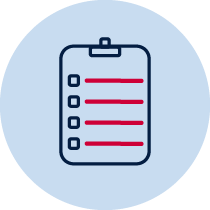Chance and data – Yes or no?
Students describe outcomes as ‘likely’ and ‘unlikely’ and identify some events as ‘certain’ or ‘impossible’.
 |
 |
 |
| Verbal recording | Teacher observation | Individual |
Statistics and probability – Chance 1, Chance 2, Data 2
- describes mathematical situations and methods using everyday and some mathematical language, actions, materials, diagrams and symbols MA1-1WM
- supports conclusions by explaining or demonstrating how answers were obtained MA1-3WM
- gathers and organises data, displays data in lists, tables and picture graphs, and interprets the results MA1-17SP
- recognises and describes the element of chance in everyday events MA1-18SP
Content
- Choose simple questions and gather responses.
- Identify a question of interest based on one categorical variable and gather data relevant to the question.
- Describe outcomes as ‘likely’ and ‘unlikely’ and identify some events as ‘certain’ or ‘impossible’.
National Numeracy Learning Progression mapping to the NSW mathematics syllabus
When working towards the outcome MA1‑18SP the sub-elements (and levels) of Understanding chance (UnC1) describe observable behaviours that can aid teachers in making evidence-based decisions about student development and future learning.
When working towards the outcome MA1‑17SP the sub-elements (and levels) of Interpreting and representing data (IRD1-IRD3) describe observable behaviours that can aid teachers in making evidence-based decisions about student development and future learning.
Materials
- paper or recording device
- yes or no downloadable
Teacher instructions
The purpose of this task is to gauge students' understanding of data concepts such as:
- data can be collected by asking relevant questions
- posing questions related to given data
- data can be categorised in a variety of ways
This task is presented orally to students. It can be delivered to the whole class or groups of students who then work on their own responses. Alternatively, it can be given as part of a one-to-one interview with individual students. If students are working independently, they should record their responses in writing or pictorially or by electronic means through video or voice recording.
Students could draw a picture to represent what the sorting might look like that matched the question they suggested. For example, the teacher might have asked, “Does your animal live in the water?” The student then draws some animals on one side of the paper like fish, turtle, shark and on the other side a dog, cow or bird.
Student instructions
A group of children drew a picture of their favourite animal. Their teacher then asked them a question. If the answer to the question was ‘yes’ they put their picture in one pile. If their answer to the questions was ‘no’ they put their picture in a different pile.
- What question might the teacher have asked?
- Can you think of other possible questions that the teacher may have asked?
Enabling prompts/possible questions: Does this animal live on a farm? Can this animal swim?
Possible areas for further exploration?
- Student makes statements rather than asking questions. (for example, I would draw a dog)
- Student asks an irrelevant question – does not relate to animal drawing
- Student asks an open question
Where to next?
Develop an understanding of asking questions through the use of picture stimuli and teacher modelling. for example,
- display a picture of a child and ask questions such as “Is he wearing shoes? Is he playing football?” Support students to devise their own questions.
- display a picture of a popular character and ask a variety of questions so that students can identify whether the question is relevant to the picture
- explicitly model the difference between open and closed questions. Label one side of the classroom ‘yes’ and the other, ‘no’. Teacher asks questions which students respond to by moving to either side of the classroom. When the teacher asks an open question, discuss why they cannot answer within the parameters of this task.
- students create their own questions which can be answered with either yes or no, they then collect the data to display.
Adapted from: Sullivan P, & Lilburn, P (1997) Open-ended Maths Activities Second edition. Oxford, New York.
Syllabus
Please note:
Syllabus outcomes and content descriptors from Mathematics K-10 Syllabus © NSW Education Standards Authority (NESA) for and on behalf of the Crown in right of the State of New South Wales, 2012